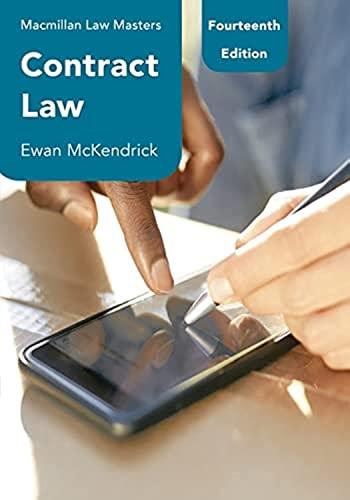Question
This Questions are from Patent Law & Pharmaceutical IndustryPatent Law & Pharmaceutical Industry Question 5 (4 points) In the CardiAQ v. Neovasc case, CardiAQ,
This Questions are from "Patent Law & Pharmaceutical IndustryPatent Law & Pharmaceutical Industry"
Question 5(4 points)
In the CardiAQ v. Neovasc case, CardiAQ, a heart valve developer, enlisted Neovasc to manufacture a prototype based on their designs and confidential information. Later, Neovasc developed and filed a patent for a remarkably similar heart valve, leading to a dispute over intellectual property rights. Which of the following best describes the core issue that led to the lawsuit?
Question 5 options:
| CardiAQ's negligence in securing a patent for their heart valve design prior to engaging Neovasc. | |
| Neovasc's independent invention of a new heart valve after ending their consultancy with CardiAQ. | |
| CardiAQ's unauthorized use of Neovasc's proprietary processes. | |
| Neovasc's use of CardiAQ's confidential information to develop a competing product. |
Question 6(4 points)
Considering the principle of absolute novelty in patent law, suppose a pharmaceutical company claims a patent for a composition comprising a novel synthetic compound X, intended to treat cardiovascular diseases. Before filing the patent, the company had detailed the synthesis and potential therapeutic uses of compound X in an international journal. Which of the following would likely impact the patent's validity?
Question 6 options:
| The company's prior publication about compound X's synthesis and uses. | |
| The company's internal reports on compound X, not shared publicly. | |
| A presentation on compound X's theoretical benefits at a private industry meeting, without revealing its chemical structure. | |
| The company's filing for a patent in another country after the publication but within a 12-month priority window. |
Question 7(5 points)
How might a pharmaceutical company utilize Inter Partes Review (IPR) as a strategy in conjunction with their district court litigation efforts?
Question 7 options:
| Focusing on IPR as a method to publicly disclose all proprietary information about their drugs, aiming to enhance industry transparency and customer trust, without linking it to district court litigation. | |
| Utilizing IPR solely to increase the duration of their own patent protection by requesting the PTAB to extend the term of their patents beyond the standard expiration date. | |
| By employing IPR to challenge the validity of a competitor's patent at the Patent Trial and Appeal Board (PTAB) as a defensive strategy to potentially invalidate patents that are subject to infringement litigation in district court. | |
| Engaging in IPR to directly negotiate lower licensing fees with competitors, without involving the PTAB or district court litigation processes. |
Question 8(2 points)
Once a patent application has been filed, no one else can legally use the invention.
Question 8 options:
| True | |
| False |
Question 9(2 points)
If I get a patent on an invention, then I don't have to worry about infringing someone else's patent
Question 9 options:
| True | |
| False |
Question 10(2 points)
Any invention can be patented if no one else has yet filed for a patent on it
Question 10 options:
| True | |
| False |
Step by Step Solution
There are 3 Steps involved in it
Step: 1

Get Instant Access to Expert-Tailored Solutions
See step-by-step solutions with expert insights and AI powered tools for academic success
Step: 2

Step: 3

Ace Your Homework with AI
Get the answers you need in no time with our AI-driven, step-by-step assistance
Get Started


